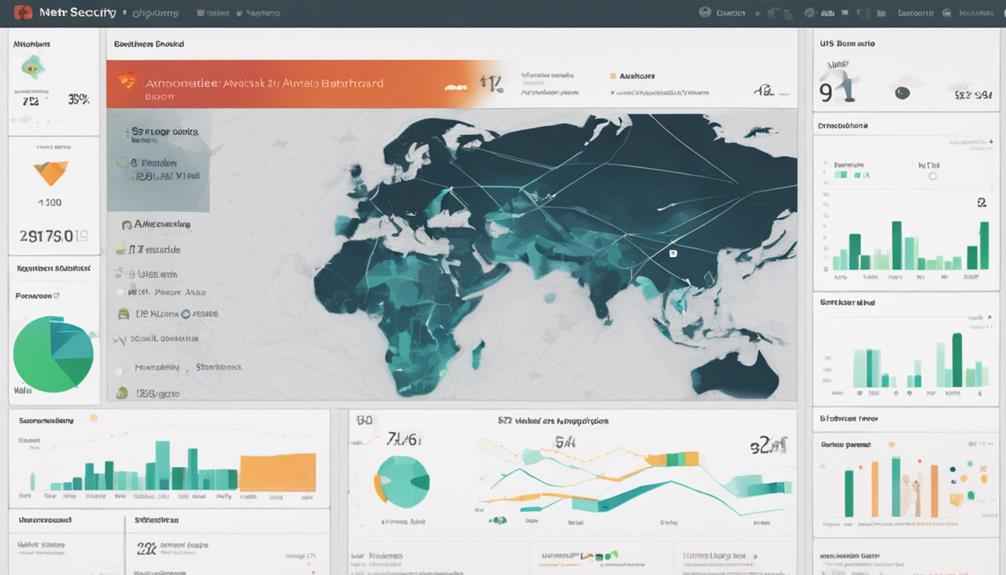AI is pivotal in cybersecurity for threat detection, endpoint protection, incident response, vulnerability identification, malware detection, fraud prevention, user behavior analytics, security operations, and adaptive access control systems. Through advanced machine learning, AI can swiftly detect unusual patterns, predict future threats, automate incident responses, and enhance vulnerability scanning. It plays a vital role in real-time threat prevention, proactive defense measures, and fraud detection accuracy. By analyzing user behavior, monitoring network traffic, and dynamically adjusting access controls, AI fortifies cybersecurity defenses. Uncover how AI safeguards against cyber threats in practical scenarios through its diverse applications in the cybersecurity landscape.
Key Takeaways
- AI enhances threat detection by analyzing network behavior.
- Predictive analytics offer insights into future threats.
- AI-driven endpoint security provides real-time threat prevention.
- Automated incident response accelerates threat containment.
- AI-powered malware detection tools neutralize evolving threats.
Threat Detection and Analysis
Artificial Intelligence (AI) plays a pivotal role in cybersecurity through its capability in threat detection and analysis. Machine learning algorithms empower AI to sift through massive amounts of data, swiftly identifying anomalies that indicate potential security incidents.
By monitoring network behavior, AI can detect unusual patterns and behaviors that may signify cyber threats, enabling real-time threat detection. This proactive approach allows organizations to respond promptly, mitigating risks before they escalate. Additionally, AI's predictive analytics offer a glimpse into future threats, aiding in preemptive security measures.
AI's ability to handle the complexity of modern cyber threats by integrating diverse data sources and automating tasks provides a robust defense mechanism. By categorizing artifacts, predicting system calls, and grouping data based on features, AI enhances threat analysis capabilities significantly.
Leveraging AI in cybersecurity not only streamlines operations but also ensures a more efficient and effective response to evolving cyber challenges.
Endpoint Protection Solutions

Endpoint protection solutions fortified with AI leverage machine learning algorithms to proactively detect and prevent malware infections on individual devices.
By incorporating AI-driven solutions, organizations can analyze user behavior and network traffic patterns to enhance endpoint security. These advanced systems offer real-time threat prevention by continuously monitoring endpoints for any signs of suspicious activities.
Through the utilization of AI in cybersecurity, endpoint protection can effectively secure devices against evolving cyber threats and zero-day attacks. Additionally, AI-enhanced endpoint security solutions play an essential role in providing proactive defense measures to safeguard sensitive data and prevent unauthorized access.
Incident Response Automation

With the rapid advancement of technology in cybersecurity, incident response automation has emerged as a pivotal strategy for accelerating threat detection and containment processes.
AI plays an important role in automating the analysis of security alerts, allowing for the swift prioritization of incidents based on severity.
By harnessing AI-driven incident response, organizations can greatly reduce response times, thereby minimizing the impact of security breaches.
Automated incident response systems excel in containing threats faster and more efficiently than manual processes, providing security teams with real-time insights and recommendations to enhance their response efforts.
Through the power of AI, incident response automation not only streamlines operations but also empowers security teams to proactively address cybersecurity incidents with speed and precision.
Embracing this technology enables organizations to stay ahead of threats, fortifying their defenses and safeguarding sensitive data effectively.
Vulnerability Identification Techniques

In the domain of cybersecurity, vulnerability identification techniques play an essential role in fortifying defenses against potential threats.
Automated Vulnerability Scanning tools efficiently pinpoint weaknesses in software and systems, enabling organizations to proactively address security risks.
Additionally, integrating Threat Intelligence and leveraging Behavior Analytics Detection further bolsters the ability to identify and mitigate vulnerabilities before they can be exploited by cyber attackers.
Automated Vulnerability Scanning
Automated vulnerability scanning, powered by AI algorithms, plays an important role in efficiently identifying and prioritizing vulnerabilities within an organization's network and systems.
These AI-driven tools are vital for automated threat detection, allowing organizations to analyze large datasets swiftly to pinpoint potential weaknesses in security defenses.
By automating vulnerability scanning, organizations can proactively stay ahead of cyber threats, reducing the time and resources needed for manual vulnerability assessments.
Real-time insights provided by AI-driven scanners offer immediate visibility into potential risks, enabling timely remediation actions to be taken.
This proactive approach enhances the organization's security posture by swiftly addressing vulnerabilities before they can be exploited.
Leveraging AI algorithms for vulnerability scanning not only streamlines the security assessment process but also empowers organizations to fortify their defenses against evolving cyber threats effectively.
Embracing automated vulnerability scanning is a proactive step towards bolstering cybersecurity resilience.
Threat Intelligence Integration
Threat intelligence integration, leveraging AI for vulnerability identification techniques, enhances cybersecurity defense strategies by pinpointing potential weaknesses in systems and networks.
By utilizing AI-powered tools to analyze threat intelligence data, organizations can efficiently identify and prioritize vulnerabilities.
Machine learning models play a vital role in this process by helping cybersecurity teams identify potential threats and security gaps accurately.
These algorithms aid in evaluating the severity of vulnerabilities and their potential impact on the organization, enabling proactive measures to address them promptly.
Through the integration of threat intelligence with AI capabilities, cybersecurity professionals can stay ahead of evolving threats and strengthen their defense mechanisms effectively.
Behavior Analytics Detection
Utilizing AI-driven behavior analytics in cybersecurity provides organizations with a powerful tool for detecting anomalies in user behavior patterns, enhancing their ability to identify potential security risks.
By employing AI in cybersecurity, behavior analytics tools can continuously monitor user actions, network behavior, and system activities to pinpoint any deviations from normal patterns that may indicate security threats. These tools compare real-time user behavior with historical data to detect anomalies that could signify security risks, enabling proactive threat detection.
When anomalies are flagged, organizations can investigate and respond promptly to mitigate potential security incidents. AI-driven behavior analytics also offer real-time insights into network behavior, empowering organizations to prioritize and address security threats efficiently.
Malware Detection and Mitigation

Malware detection and mitigation are critical aspects of cybersecurity where AI plays a pivotal role. Through analyzing code patterns and behaviors, AI can swiftly identify and combat malicious software, bolstering threat detection capabilities.
AI in Malware Detection
The integration of artificial intelligence technology in cybersecurity has revolutionized the field of malware detection and mitigation. AI plays an important role in enhancing security measures against cyber threats by utilizing machine learning to detect malicious behavior and anomalies in real-time. By analyzing patterns and behaviors, AI-powered systems can effectively identify and neutralize malware.
Machine learning algorithms enable the detection of new malware variants by leveraging historical data and known patterns, improving the accuracy and efficiency of threat identification. These AI-driven malware detection tools can efficiently analyze large volumes of data, providing a proactive defense mechanism against evolving cyber threats.
Continuously monitoring for suspicious activities, AI helps in strengthening cybersecurity defenses by swiftly identifying and mitigating potential malware risks. The use of AI in malware detection not only enhances the speed of threat identification but also establishes a more robust and reliable security infrastructure.
Mitigating Cyber Threats
AI's application in cybersecurity extends beyond malware detection, encompassing the critical aspect of mitigating cyber threats through proactive measures. By utilizing machine learning models, AI systems can analyze patterns in code to prevent potential cyberattacks.
Real-time detection is a key feature of AI-powered security solutions, enabling prompt responses to emerging threats. Behavioral analytics, another essential component, allows AI to identify abnormal user behavior that may indicate malware infection or unauthorized access.
Endpoint protection solutions driven by AI establish baseline behavior, enhancing the ability to detect anomalies and combat sophisticated malware attacks effectively. With AI's ability to detect and respond to threats swiftly, organizations can bolster their cybersecurity defenses and minimize the impact of security breaches.
Data Breach Prevention Strategies

Utilizing advanced machine learning algorithms, cybersecurity professionals implement data breach prevention strategies that analyze user behavior patterns to proactively detect and mitigate potential security threats.
By monitoring for anomalies and unauthorized activities through these machine learning algorithms, organizations can prevent data breaches before they occur.
AI-powered tools play an essential role in monitoring network traffic in real-time, flagging any suspicious activities or abnormal data transfers that could lead to a breach of sensitive data.
Moreover, behavioral analytics, powered by AI, can effectively detect insider threats or compromised accounts, thereby reducing the risk of data breaches caused by internal actors.
These proactive threat prevention measures offered by AI-driven security solutions enhance organizations' ability to safeguard sensitive data effectively.
AI in Security Operations Centers

In addition, implementing advanced artificial intelligence technologies revolutionizes the operations of Security Operations Centers (SOCs), enhancing their ability to detect and respond to security threats effectively.
AI tools in SOCs analyze vast amounts of data in real-time, enabling quick identification of security incidents. By automating threat detection and response processes, AI-powered SOCs streamline operations and prioritize alerts, reducing false positives that can overwhelm traditional methods. This efficiency allows AI to detect and mitigate threats faster, improving overall cybersecurity posture.
Additionally, AI in SOCs enables proactive security measures by predicting potential cyber threats before they materialize, giving organizations a strategic advantage in safeguarding their digital assets.
The integration of AI not only enhances the capabilities of SOCs but also underscores the importance of leveraging technology to stay ahead in the ever-evolving landscape of cybersecurity.
Fraud Detection and Prevention

In the domain of cybersecurity, AI plays a pivotal role in enhancing fraud detection accuracy.
By analyzing intricate patterns in financial transactions, machine learning algorithms can swiftly pinpoint suspicious activities, enabling real-time prevention strategies to be implemented effectively.
These AI-powered systems not only streamline the detection process but also greatly reduce false positives, thereby bolstering overall fraud prevention efforts.
Fraud Detection Accuracy
Enhancing fraud detection accuracy in cybersecurity involves leveraging AI technology to analyze data patterns and anomalies indicative of fraudulent activities. Machine learning algorithms play a pivotal role in this process by monitoring user behavior and flagging potential fraud attempts in real-time. By reducing false positives and improving detection rates, AI-powered fraud detection systems enhance financial security for organizations.
Moreover, adaptive AI models are capable of learning and evolving with new fraud patterns, ensuring proactive fraud prevention measures are in place. These models continuously monitor transactions and user activities, swiftly identifying any suspicious behavior that may indicate fraudulent actions.
Real-Time Prevention Strategies
Utilizing AI technology for real-time fraud detection and prevention in cybersecurity involves employing advanced algorithms to analyze financial transactions swiftly and accurately. AI-powered systems leverage machine learning algorithms to detect and prevent fraudulent activities by monitoring patterns and anomalies in user behavior and transaction data.
These real-time prevention strategies enable financial institutions to mitigate risks and reduce potential losses by instantly identifying and stopping fraudulent transactions before they occur.
User Behavior Analytics

User Behavior Analytics, powered by AI, revolutionizes cybersecurity by analyzing user actions to identify potential security threats. This innovative approach to cybersecurity offers a proactive method for detecting anomalies and potential malicious activity by focusing on user behavior patterns.
Here's how AI-powered User Behavior Analytics enhances cybersecurity:
- Detect Anomalies: By tracking user behavior patterns, User Behavior Analytics can establish baselines and quickly detect deviations that may indicate security threats.
- Identify Potential Threats: It helps security teams prioritize alerts and respond effectively to potential security incidents by identifying suspicious user activities.
- Enhance Incident Response: By monitoring user activities across networks and systems, User Behavior Analytics improves threat detection capabilities and enables more efficient incident response.
- Mitigate Insider Threats: This technology plays a crucial role in identifying insider threats, unauthorized access, and abnormal user behavior that traditional security measures may overlook, enhancing overall cybersecurity posture.
Adaptive Access Control Systems

Adaptive access control systems, powered by AI algorithms, dynamically adjust user privileges based on risk assessments and behavior patterns. By continuously monitoring user activity, these systems can identify anomalies in real-time and mitigate potential security threats effectively.
Through the implementation of personalized access controls and continuous authentication, AI in adaptive access control bolsters cybersecurity measures within organizations.
Machine learning plays a pivotal role in these systems, enabling them to proactively prevent unauthorized access and data breaches. The adaptive nature of these controls allows for swift adaptation to evolving threats and user behaviors, providing a robust defense mechanism against cybersecurity risks.
Organizations leveraging adaptive access control systems benefit from enhanced security protocols that align with the dynamic landscape of cybersecurity challenges, ensuring a proactive approach to safeguarding sensitive information.
Frequently Asked Questions
What Is a Real Life Example of AI in Cyber Security?
In the domain of cybersecurity, AI plays a pivotal role in real-world scenarios by bolstering threat detection capabilities, automating incident response processes, and enhancing security postures through behavioral analytics. Its application in safeguarding digital assets is indispensable.
What Is the Application of Cyber Security in Real Life?
In real life, cybersecurity applications are akin to sentinels guarding digital fortresses. They encompass threat detection, incident response, and proactive defense strategies. Through AI, organizations analyze data to identify and mitigate cyber threats effectively.
How Is AI Used in the Real World?
In the real world, AI is extensively employed across various industries to streamline processes, enhance decision-making, and drive innovation. Its applications range from personalized recommendations in e-commerce to predictive maintenance in manufacturing, showcasing its versatility and impact.
How Is AI Used in Cyber Crime?
AI in cyber crime is a formidable adversary, empowering malicious actors to automate attacks, craft sophisticated phishing emails, and conduct targeted ransomware assaults. Adversarial AI techniques deceive security systems, enabling the creation of advanced malware and cyber weapons.
Conclusion
To sum up, the implementation of AI in cybersecurity has revolutionized the way organizations protect their data and systems. By utilizing advanced technologies such as threat detection, endpoint protection, incident response automation, and user behavior analytics, companies can stay one step ahead of cyber threats.
As the digital landscape continues to evolve, integrating AI into cybersecurity practices is essential to safeguarding sensitive information and maintaining secure environments. As the saying goes, 'Knowledge is power' – and in this case, knowledge backed by AI is key to staying safe online.









